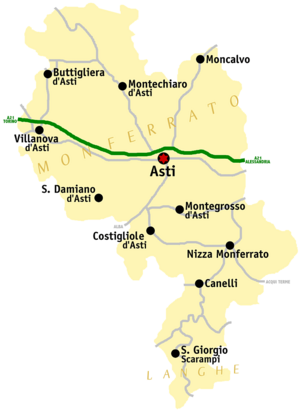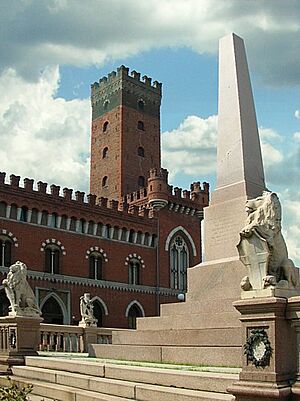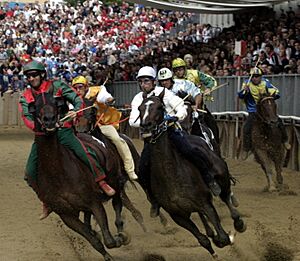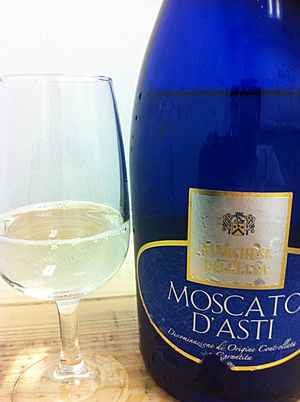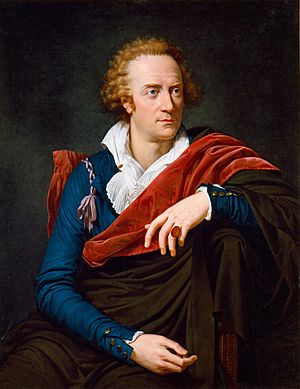Asti facts for kids
Quick facts for kids
Asti
Ast (Piedmontese)
|
|||
|---|---|---|---|
| Comune di Asti | |||
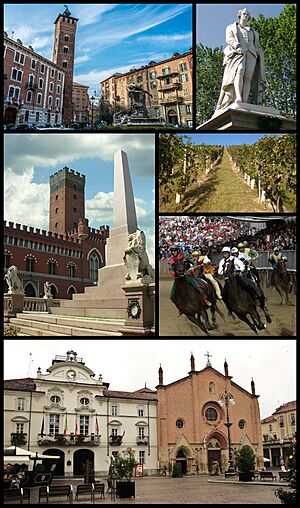
Top left: Piazza Medici ("Medici Square") and Troyana Tower; top right: a monument of Vittorio Alfieri in Piazza Alfieri ("Alfieri Square"); middle left: Piazza Roma ("Rome Square") and Comentina Tower; middle upper right: vineyards in Mongardino; middle lower right: Palio di Asti Festival on September; bottom: town hall and San Secondo church
|
|||
|
|||
| Country | Italy | ||
| Region | Piedmont | ||
| Province | Asti (AT) | ||
| Frazioni | see list | ||
| Area | |||
| • Total | 151.31 km2 (58.42 sq mi) | ||
| Elevation | 123 m (404 ft) | ||
| Population
(1-1-2021)
|
|||
| • Total | 74,348 | ||
| • Density | 491.362/km2 (1,272.62/sq mi) | ||
| Demonym(s) | Astigiano(i) | ||
| Time zone | UTC+1 (CET) | ||
| • Summer (DST) | UTC+2 (CEST) | ||
| Postal code |
14100
|
||
| Dialing code | 0141 | ||
| Patron saint | Saint Secundus of Asti | ||
| Saint day | First Tuesday of May | ||
Asti is a city in the Piedmont region of Italy. It has about 74,000 people living there. The city is located about 55 kilometers (34 miles) east of Turin. It sits in the flat area near the Tanaro River. Asti is the main city of the province of Asti. Many people also see it as the modern capital of the Montferrat area.
Contents
History of Asti
Early Times and Middle Ages
People have lived in the Asti area since the Stone Age. Before the Romans arrived, a group called the Ligures lived here. The name "Asti" might come from an old Celtic word meaning "hill."
In 124 BC, the Romans built a fort called castrum here. This fort grew into a city named Hasta. In 89 BC, it became a Roman colony. By 49 BC, it was a municipium, which was an important Roman town. Asti was important because it was on the Tanaro River and a main road. This road connected it to other big cities like Turin.
Asti played a key role during the early barbarian invasions. In 402 AD, the Visigoths attacked northern Italy. The young Roman emperor, Honorius, had to escape from Milan. He found safety in Asti. The Goths surrounded Asti, but Roman General Stilicho arrived and defeated them. After this, Asti faced more invasions and became less wealthy.
In the 6th century, the Lombards made Asti one of their main areas. Later, when the Franks took over, it became a county. By the late 800s, bishops ruled Asti. They were powerful landowners. In 1095, Asti became one of the first free cities in Italy. It started to govern itself with its own leaders.
Growing Power in the Middle Ages
Asti became a free city very early in Italy. In 1140, it even got the right to make its own coins. However, the city started taking land from the bishops and other local lords. These lords asked Emperor Frederick Barbarossa for help. In 1155, he attacked Asti, and the city was burned.
Even so, Asti joined other cities against the emperor in 1169. They were called the Lombard League. Asti was defeated again in 1174. But after a peace treaty in 1183, Asti gained even more rights.
The 1200s were a golden age for Asti. It became very rich and important. The city fought wars against nearby towns to control trade routes. These routes led from the Ligurian ports to the north. Powerful banking families grew in Asti. They often fought among themselves, supporting different political groups.
Asti sided with Emperor Frederick II in his wars. The city became very strong in Piedmont. It even controlled nearby cities like Turin. But these internal fights caused problems. In 1314, a powerful banking family gave the city to King Robert of Naples. This ended Asti's time as a free republic.
Over the next years, Asti changed hands many times. It was ruled by different powerful families and leaders from Milan and Montferrat.
French and Savoyard Rule
For a long time, Asti was under French control. This changed in the early 1500s during wars between France and the Holy Roman Empire. In 1529, Asti was given to the German emperor. He then gave it to the Duke of Savoy.
Asti became an important fort for the Savoy family. It was attacked many times in the 1600s. In 1630-31, many people in Asti died from the plague. The city was captured by the Spanish, but Savoy got it back. In 1703, during the War of Spanish Succession, France took Asti again. But Savoy won it back in 1705.
In 1797, the people of Asti were tired of wars and hard times. They revolted against the Savoy government and declared their own republic. But it lasted only two days. The leaders were arrested and executed. The next year, the French army, led by Napoleon, took over Piedmont. Napoleon himself visited Asti in 1805. The city became part of a larger French area. After Napoleon's empire ended, Asti returned to Piedmont in 1814. The city then followed Piedmont's history until Italy became one country in 1861.
Geography and Climate
Asti has a climate that is affected by the nearby Mediterranean Sea. This means its winters are warmer than Turin's, and its summers are cooler. Most rain falls in spring and autumn. In the hottest months, rain is less common but can be very strong, often as thunderstorms. In November and December, Asti can sometimes have fog.
| Climate data for Asti (1998–2020) | |||||||||||||
|---|---|---|---|---|---|---|---|---|---|---|---|---|---|
| Month | Jan | Feb | Mar | Apr | May | Jun | Jul | Aug | Sep | Oct | Nov | Dec | Year |
| Mean daily maximum °C (°F) | 6.8 (44.2) |
9.8 (49.6) |
15.1 (59.2) |
19.0 (66.2) |
23.3 (73.9) |
28.2 (82.8) |
30.7 (87.3) |
30.1 (86.2) |
25.1 (77.2) |
18.6 (65.5) |
11.9 (53.4) |
7.1 (44.8) |
18.8 (65.9) |
| Daily mean °C (°F) | 2.4 (36.3) |
4.4 (39.9) |
9.0 (48.2) |
13.1 (55.6) |
17.4 (63.3) |
22.1 (71.8) |
24.2 (75.6) |
23.8 (74.8) |
19.2 (66.6) |
13.7 (56.7) |
7.8 (46.0) |
3.0 (37.4) |
13.3 (56.0) |
| Mean daily minimum °C (°F) | −1.9 (28.6) |
−0.9 (30.4) |
2.8 (37.0) |
7.2 (45.0) |
11.6 (52.9) |
15.9 (60.6) |
17.8 (64.0) |
17.6 (63.7) |
13.3 (55.9) |
8.8 (47.8) |
3.8 (38.8) |
−1.0 (30.2) |
7.9 (46.2) |
| Average precipitation mm (inches) | 42 (1.7) |
49 (1.9) |
55 (2.2) |
70 (2.8) |
87 (3.4) |
42 (1.7) |
43 (1.7) |
48 (1.9) |
56 (2.2) |
66 (2.6) |
98 (3.9) |
52 (2.0) |
708 (28) |
| Average precipitation days | 5 | 5 | 5 | 7 | 8 | 5 | 4 | 4 | 5 | 6 | 8 | 6 | 68 |
| Source: Climi e viaggi | |||||||||||||
Main Sights
You can still see parts of the old city walls on the north side of Asti. Recently, Roman walls were found in the city center.
The area northwest of the city, near the cathedral, has many old palaces and merchant houses. Many of these have tall towers. Asti was once known as the "city of 100 towers." Some of these towers still stand today:
- The Tower of the Comentini (from the 1200s).
- The eight-sided Torre de Regibus.
- The Torre Troyana (also from the 1200s).
- The ancient Torre Rossa, built when the Roman Emperor Augustus ruled.
Asti also has several old churches:
- Cathedral of Santa Maria Assunta: Built in the 1200s, it's one of the biggest cathedrals in Piedmont. It has a tall bell tower from 1266. Inside, you can see 18th-century paintings and old silver artworks.
- Collegiata di San Secondo: This church from the 1200s is in the old city center. It's named after the city's patron saint, Secundus of Asti. Its crypt is even older, from the 500s.
- Santa Maria Nuova (11th century).
- San Martino: First mentioned in 886, it was rebuilt in the 1700s in the Baroque style.
- Sant'Anastasio (8th-12th century): Its museum shows old stone carvings.
- Santa Caterina: A Baroque style church.
- Baptistery of San Pietro: This 12th-century building has an eight-sided shape and a large dome.
- San Pietro in Consavia (15th century): This church has beautiful outside decorations. It also houses the Archaeological Museum, with Roman and Egyptian items.
Asti also has a synagogue and a museum about the history of the Jewish community in Asti, which has been there since 812.
Events
One of the most famous events in Asti is the Palio di Asti. In this event, different parts of the old town and nearby villages race horses without saddles. This race remembers a victory in a battle against the city of Alba long ago. After the battle, a race was held around Alba's walls. Since then, it has been held every year in Asti. Asti's Palio is the oldest recorded horse race of its kind in Italy. Today, it takes place in Piazza Alfieri on the third Sunday of September. Before the race, there's a big parade through the old town with people dressed in medieval costumes.
Wine
The areas around Asti are famous for their wines. The soil here is perfect for growing grapes. Asti is known for making sparkling Asti wine, often called Asti Spumante. This wine is usually sweet and has low alcohol. It's made from the moscato bianco grape. Another popular wine is Moscato d'Asti, which is a premium version. Red wines like Barbera d'Asti are also very popular.
Many wines from Asti are known worldwide. Companies like Martini and Rossi, Gancia, and Riccadonna started here. You can try these wines and many others at the Douja d'Or wine exhibition. This event happens at the same time as the Palio.
Food
Asti is also famous for its Asti's Festival of Festivals. This festival takes place in September, a week before the Palio. During this event, many towns from the Asti province gather in a large square called "Campo del Palio." They offer their special local food and wine. On the Sunday of the festival, all the towns have a parade. They use floats that show traditional farming life, and everyone wears costumes. The parade goes through Asti's streets to the "Campo del Palio" square.
From October to December, Asti province is a great place for food lovers because it's the season for white truffles. While a nearby town, Alba, is more famous for its truffle fair, some of the best truffles are found in Asti's hills. There's a local truffle festival almost every weekend during this time.
Sport
Asti has a football club called A.S.D. Asti. There is also a futsal (indoor football) team, A.S.D. Asti Calcio a 5, which has won championships.
Transport
Asti railway station opened in 1849. It is part of the main railway lines connecting Turin to Genoa and Castagnole to Mortara. It is also a connection point for other lines going to Genoa and Chivasso.
Famous People from Asti
Many notable people come from Asti:
- Gandolfino d'Asti (active 1493–1518): A painter from the Renaissance period.
- Vittorio Alfieri (1749–1803): A famous writer who is known as the "founder of Italian tragedy."
- Isaac Artom (1829–1900): A writer, diplomat, and politician.
- Michelangelo Pittatore (1825–1903): A portrait painter.
- Umberto Cagni (1863–1932): A polar explorer and admiral.
- Carlo Alberto Castigliano (1847–1884): A mathematician and physicist.
- Mikhail Tsvet (1872–1919): A Russian-Italian botanist who invented chromatography.
- Ettore Desderi (1892–1974): A composer known for his sacred music.
- Paolo Conte (born 1937): A painter, poet, and songwriter.
- Giovanni Goria (1943–1994): A politician who was Prime Minister of Italy from 1987 to 1988.
- Giorgio Faletti (1950–2014): A writer, actor, and singer-songwriter.
- Maurizio Lobina (born 1973): A musician and member of the famous dance music band Eiffel 65.
- Matteo Paro (born 1983): A footballer.
- Rinaldo Capello (born 1964): A race car driver who won the 24 Hours of Le Mans three times.
- Fabio Mengozzi (born 1980): A pianist and composer.
- One of Pope Francis's cousins is from Asti. His father moved to Argentina from the Asti area.
International Relations
Asti is twinned with several cities around the world. This means they have special friendly relationships:
 Miami-Dade, Florida, United States (since 1985)
Miami-Dade, Florida, United States (since 1985) Valence, France (since 1966)
Valence, France (since 1966) Biberach an der Riß, Germany
Biberach an der Riß, Germany Ma'alot-Tarshiha, Israel
Ma'alot-Tarshiha, Israel Nanyang, Henan, China
Nanyang, Henan, China
Images for kids
See Also
 In Spanish: Asti para niños
In Spanish: Asti para niños





